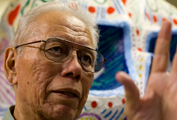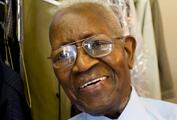Aging on the Job

As the population ages, so does the workforce. People keep working longer, while at the same time record numbers are retiring. Older adults who need jobs are enduring longer periods of unemployment. Traditional career paths are being reconsidered; the concept of retirement itself may be broken. As American companies and older workers scramble to find mutually beneficial relationships — phased retirement, knowledge transfer, late-career training — uncertainty reigns.
Our News21 reporters and producers visited with older workers in many fields — a well-driller, a neurologist, a shopkeeper — to talk about why, past age 65, they still get up for work every day. We talked to companies watching 30-year veterans leave, without qualified people to take their places. Ultimately, we encountered people who, at every age, are rethinking what work means.
Instead of Retirement, Training Their Own Replacements
-
In December 2000, Johnney Pollan retired from Dow Chemical after 31 years as a chemical process operator in East Texas. The timing seemed perfect.
With his pension and health care benefits, Pollan could live comfortably with his wife in Lake Jackson and devote more time to his hobby, amateur archaeology. And the company had begun using alternatives to DowTran, the proprietary computer language Pollan had used for years to run processes in its Freeport, Texas, plant.
But within a year of Pollan's retirement, Dow decided to continue using DowTran for the foreseeable future, even though most of the few hundred people who knew it had retired along with him.
So Dow asked him to come back, this time as a contractor in one of the same plants where he'd worked. Pollan accepted and has put his retirement plans on a decade-long hold.
"I think the company has realized that, in the last decade, a lot of the expertise was going out the door," he says, now 64 and heavyset, with a relaxed drawl. "And they found that they really needed it."
Pollan's experience is prologue to a much larger wave of retirements facing the region's petrochemical industry. Of the 4,200 Dow employees in Freeport, about 40 percent will be eligible for retirement within four years.
Nationally, similar trends are emerging. Yet human resources experts, workers and executives from a range of industries believe that businesses are largely unprepared to accommodate an aging workforce or to cope with its eventual retirement. "They are oblivious," says economist Steven Sass, of the Center for Retirement Research at Boston College.
Many industries find themselves in a quandary: They often need older workers for their expertise, yet also may need to accommodate their physical disabilities and desires for more flexible schedules. And as workers stay on the job longer, they may need training in new technologies or work procedures; they can also change the way companies hire.
In the past decade, the number of seniors in the labor force has grown nearly 60 percent, according to the Bureau of Labor Statistics. By 2018, the number of 65-plus workers will climb from 6.5 million today to 11 million, BLS projections indicate.
That's partly because many baby boomers, healthier and better educated than any previous generation, plan to continue working, at least part time, well past traditional retirement age. Human resources managers say voluntary retirement nearly stopped after the stock market collapse in 2007. "When do people choose to retire?" says Karen Smith, a senior researcher at the Urban Institute. "When they are able to replace their income."
So employers face a dual challenge: They have to keep older workers productive and then, when those workers do ultimately leave, find qualified people to replace them. In 22 industries, from engineering and agriculture to real estate and health care, more than three in 10 workers are already 50 or older, according to a 2007 study from the Sloan Center on Aging and Work at Boston College.
"Suddenly, there's this call that the baby boomers are retiring," says Peter Cappelli, director of the Center for Human Resources at the University of Pennsylvania's Wharton School. "What did you think they were going to do? Stay until they die?"
"Companies are not very long term-oriented," he adds. "They don't spend much time worrying about what might be coming down the pipe in the future."
In a third-floor hotel conference room in Cambridge, Mass., near biotech labs and the buildings of MIT, several dozen human resources managers recently paid more than $2,000 each to learn more about what's called workforce planning — how to make sure a business has the right people for the job now and in the future.
Bob Redlo, who spoke to the group one afternoon, leads workforce planning and development at Kaiser Permanente, with 8.8 million members the nation's largest managed health care company. Kaiser's aging workforce is a critical issue, he says.
Last year, almost 12,000 Kaiser employees retired — more than seven percent of the company's workforce. Forty percent of its nurses are older than 50. The average age of its clinical lab scientists is 57; they typically retire at 63.
"It's been mitigated a little because of the economy, but I think it's a huge problem for us," Redlo says. Age and experience mean better quality and patient satisfaction, he says. Older workers are also highly trained and can be expensive to replace.
Call it the bathtub effect. Among the missile and fire control engineers at Lockheed Martin, "most were hired into the industry in the '60s and '70s," says Gary McPherson, vice president of human resources for the division. Then new hiring dropped off, which means fewer workers between age 35 and 45.
Graph it out on a piece of paper and you see "a bathtub in the middle," between the original generation and a wave of recent college graduates, he says. Forty to 60 percent of McPherson's division will reach retirement age at the same time.
Like many companies, Lockheed focuses on the 15 to 20 percent of older workers in what McPherson calls "very critical positions," like lead missile propulsion engineers. Though the company has developed mentoring programs that pair veterans with younger workers to pass on experience, the chief risk — as at Dow — is that there simply aren't enough qualified replacements.
In Texas, home to both companies, public schools have de-emphasized vocational education, says John Ray, dean of information and community resources at Brazosport College.
"Today, you don't have students with experience in working with their hands," Ray says. Brazosport, a community college near Freeport, has joined with petrochemical companies to train students while hosting courses for new hires at companies like Dow and BASF.
While Dow has recognized the long-term employment trends the industry confronts — "we're having to look for alternative supplies," says Troy Bearden, Dow's services leader for its Houston area operations — the consequences are sobering.
"If you would ever get into a situation when you didn't have the trained and skilled folks available to operate the units," says Bruce Raiff, who oversees "knowledge transfer" programs for Dow's Texas operations, "you'd have to shut the units down."
Employers in other industries, coping with the same employment profile, say they face their own challenges. Disability costs can rise because older workers may be more easily injured. Workplace adaptations to accommodate decreased mobility may be needed.
On the flip side, older workers who don't retire could slow the career ladder for younger workers, while newer technology that is second nature to millennials can put off older workers.
Yet older workers are also more highly engaged and absent less often than young workers, according to the Sloan Center on Aging and Work.
Any of these issues can create intergenerational tension, and managers may have to adapt to an unprecedented range of ages in the workplace.
Some companies have already taken action, designing programs to allow older workers to move to more flexible jobs, teach part time, or retain health benefits via phased retirement.
Older nurses at Kaiser, for example, can switch to less physically demanding positions while training the next generation of health care workers. Nursing schools aren't doing the job, says Kaiser's Redlo, and his nurses make excellent instructors because they know the hospital system.
Other health care companies, like John Muir Health near San Francisco, have designed new facilities to ease the physical strain on older workers, incorporating ergonomic equipment, increased automation and more efficient floor plans.
Many companies have joined with academic institutions to pass knowledge from an older generation to younger ones.
Two years ago, Brazosport College opened its Center for Processed Technology, a sleek building with modern classrooms and simulated control rooms. Outside the building, a glycol and water distillation plant, 10,000 square feet of metal pipes, tanks and switches, resembles the chemical plants lining the highways in nearby Freeport. The center and plant are underwritten in part by local employers like Dow and BASF.
"The equipment is smaller in scale but it behaves just like the real thing," says Bennett Willis, 69, who worked at Dow for 33 years and has taught at Brazosport for 12. Since 2006, Dow has sent new hires who don't have a degree in processed technology to a 14-week training program at Brazosport, taught by retired Dow employees like Willis and Pollan. Fifty-three students have completed the program this year.
On a recent weekday, a class of new Dow employees learned to control the temperature of a chemical process. Student Cameron Keating, a 40-year-old Army veteran, communicated via walkie-talkie with students and instructors in an imitation control room, where a flipped switch could simulate a catastrophe — a temperature gauge reading rising to unsafe levels. Keating and his classmates had to figure out how to fix it.
"You need to increase the output, P-111," Keating said, referring to a liquid control pump.
"You mean 112?" asked the voice on the other end.
"Oh yeah, 112," Keating responded. "Should be 40 percent."
The rate stabilized, the system temperature dropped and the faux-crisis was averted.
Elsewhere, phased retirement programs allow older workers to work fewer hours but retain full benefits, including employer-sponsored health care. At Scripps Health in Southern California, longtime workers over 55 years old are eligible, says Vic Buzachero, who designed the program. Not everyone can participate: An employee's department needs to accommodate part-time work, standard for nursing but less common in management and administration.
But phased retirement has worked for Kathy Frederick, 64, who cut back five years ago after working 60-hour weeks as an assistant hospital administrator near San Diego. "As you age, it becomes a little bit hard to work that hard," she says. Still, Frederick wasn't sure her savings were sufficient for a comfortable retirement, and she knew she could still contribute to the company.
She and Buzachero designed a part-time position doing special projects, leaving Frederick time to travel and kayak.
In academia, Arizona State University and other institutions have created incentives for older, tenured faculty to retire in order to open positions for younger faculty and reduce costs.
At Sodexo, which provides food service and facility management, employee feedback led to the creation of an employee group on intergenerational workplace issues with regional chapters across the country.
"It's not like Gen Xers and Gen Yers need to be like their baby boomer boss," says Chris Weiser, who leads the group. "It's not about baby boomers having to learn to text 140 words a minute. It's about understanding that everyone has some style differences."
"For the first time in history you have four generations in the workplace," he added. "It's critical that we have these conversations."
"Retirement policies are intended to retain and attract," says Sass of the Center for Retirement Research. But boomers reaching retirement age in droves could transform the relationship between older workers and their employers. "End-of-career employment in the private sector will have to change," Sass says.
If the process is already under way in health care and engineering, progress elsewhere is slower. Pension rules that reduce benefits for part-time work, the threat of age discrimination lawsuits and existing union contracts can protect older workers, but they also prevent change.
Employment also looks different for older workers than for younger ones, experts say. It takes them more than a year, on average, to find work, compared to 36 weeks for those under age 55, according to the Bureau of Labor Statistics. Older workers today are more likely than ever to change jobs after they turn 50, often because of layoffs or buyouts. For many, that means a second career — and lower wages — in a different field. And low-income workers face greater risk as they age, Sass says.
The upshot, according to experts, workers and executives alike, is that the conventional notion of retirement has broken down.
"In the absence of employer-defined benefit plans, the structure that eased employees into retirement no longer exists," Sass and Alicia Munnell wrote in their 2008 book, "Working Longer."
But Kaiser's Redlo says employers will adapt, adding, "It's good for our business to keep our older workers working."
In some cases, it's good for the employees as well.
"Sure, you could pay me more money and I could work less hours, but I don't think that's going to happen," says Pollan, the once-retired Dow employee. "I enjoy doing what I do."
The Voice of Experience to the Ears of the Young
-
Three young women in hard hats and goggles peer up toward a network of tanks and valves. Recent hires at Dow Chemical's East Texas operations, they're practicing how to start an air compressor system.
"This one over here is a bypass, right?" one woman in a pink shirt asks her classmate. "The one in the middle is a bypass?"
"Yes," the classmate replies, not looking up from her clipboard. The pink-shirted trainee climbs a ladder, grips a yellow lever and, after some struggle, twists it downward.
Nothing noticeable happens, but that's the point: This is a dry run, at a replica chemical plant at Brazosport College, near Freeport, Texas. This replica, a 10,000-square-foot glycol and water distillation plant, gives new hires without degrees in processed technology a chance to transfer textbook chemical plant lessons to real equipment.
The training courses, the simulated plant and a sleek new classroom building — the BASF Center for Processed Technology, which opened in 2009 — are part of a multimillion-dollar effort, underwritten by the petrochemical industry, to recycle the knowledge of retiring employees.
-
In Texas, the public school system has shifted away from vocational education and technical instruction, creating a shortage of people qualified for petrochemical jobs, says John Ray, dean of information and community resources at Brazosport. At the same time, companies like Dow Chemical and BASF, which expanded rapidly near the Gulf Coast in the 1950s and '60s, face losing a large part of their skilled workforce to retirement.
"A lot of experience walked out the door," says Bennett Willis, 69, a retired Dow employee, now a Brazosport instructor.
When Willis retired in 1998, many of his peers left with him, and the exodus continues. Of Dow's 4,200 employees in East Texas, about 40 percent will be retirement-eligible by 2015, the company estimates.
The companies themselves used to provide such training and facilities like these on site, says Larry Kirby, a Dow plant operator for 30 years, now teaching at Brazosport. "It was a safety net." But as the recession hit and the workforce shrunk, training has been outsourced and the "safety net is not there," Kirby says.
-
If Dow and Brazosport metrics are correct, however, they may be closing the knowledge gap. Institutional knowledge is difficult to measure, but Willis says graduates of the college's two-year processed technology program test at the same proficiency level as someone with three to five years' industry experience.
Nationally, a core curriculum for processed technology was developed about a decade ago by the Center for the Advancement of Processed Technology, under a National Science Foundation grant. The center also better connects companies like Dow and BASF to those graduating with a processed technology degree, which doesn't remedy under-enrollment in such programs but does ensure that most students will get jobs, Willis says.
To his generation, the workforce gap reflects not only numbers but a shift away from what he calls "let's-go-do-something kind of work" and toward "thinking jobs."
"The United States needs to maintain a manufacturing base," he says. "As somebody remarked once, 'We can't make a living, everybody shining everybody else's shoes.' You just need to make something."
Asking Only Workmen's Wages
-
Kathleen Smith, a veteran teacher, planned to finance her retirement with money from the sale of her Arizona home. When it failed to sell after a year on the market and the bank foreclosed on it, she moved to New York City to be close to her youngest son and grandson, and tried to find work.
Eventually, she found her way to Partners in Care, which trains home health aides and places them with elderly or disabled clients. Now 63, Smith didn't picture her retirement years this way.
Although employers have started to recognize the value of older workers, people past traditional retirement age who want or need to remain in the workforce often struggle to find jobs. They may have to tackle new fields, and often find that wages in a second career are lower.
Maria Serrano, senior employment director of the New York City Department for the Aging, says the number of older people seeking work has grown in recent years.
-
Last year, her office placed around 1,000 such employees, partly through its office training and job placement program for over-55 workers with less than $25,000 annual income. The department pays $7.25 an hour during training and most commonly places older workers as home health aides or security guards, Serrano says.
But whether such programs can handle a larger increase in older workers is unclear. The department's senior employment budget fell by $2 million last year — 25 percent of its budget — following cuts to such programs nationwide. The department says it has made an effort to serve as many people as possible, but that fluctuating budgets inevitably affect enrollment.
Smith's experience is similar. She first came to the Department for the Aging last December, having registered for several similar elder worker placement programs with no luck. Smith's modest pension and Social Security barely cover her monthly living expenses. She spends just over half her monthly income on diabetes and thyroid medications and health insurance premiums.
-
Although Smith graduated from the department's office-training program, she says it no longer matters that she can type 80 words a minute. "People want Outlook, they want Excel," she says — but department trainers "told us they weren't going to teach us that, because they didn't have the time."
So the department placed Smith with Partners in Care. After three weeks' training, she placed at the top of her class on the written exam. Yet starting out as a certified home health aide, Smith has had trouble finding stable, weekly assignments she can count on. And she won't qualify for health insurance from Partners in Care unless she works 120 hours a month for two consecutive months.
But Smith keeps going. She says she's lucky to have found a program like Partners in Care "that can get older people like me some sort of job right away," she says, and can lead to other opportunities. She has interviewed for a more stable home health aide job on Long Island, hoping it can help her save $100 a day for five years in order to buy a house in an aunt's retirement community in New Jersey.
-
The job would pay $140 a day — but the Long Island Rail Road ticket costs $22 round trip and Smith needs to be two years older to get the senior discount.
Asked if she is optimistic, she laughs. "Not really," she says. "I'm pissed. But what can I do?"



















